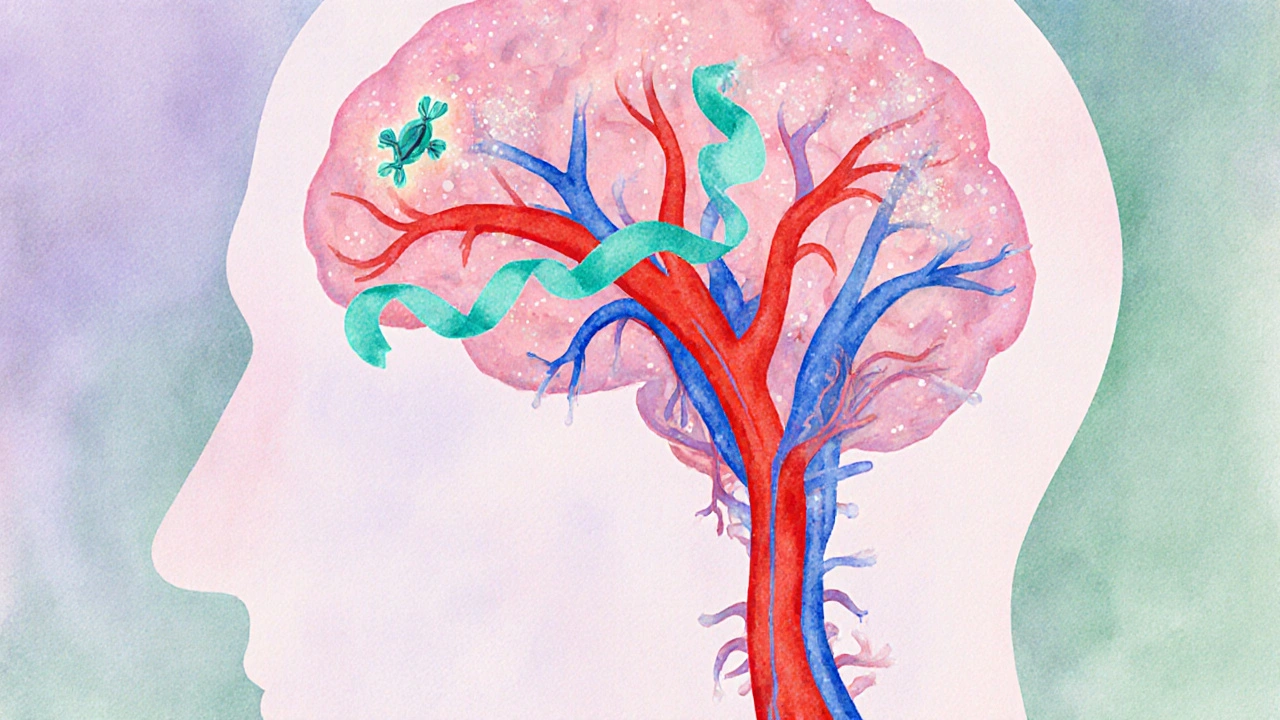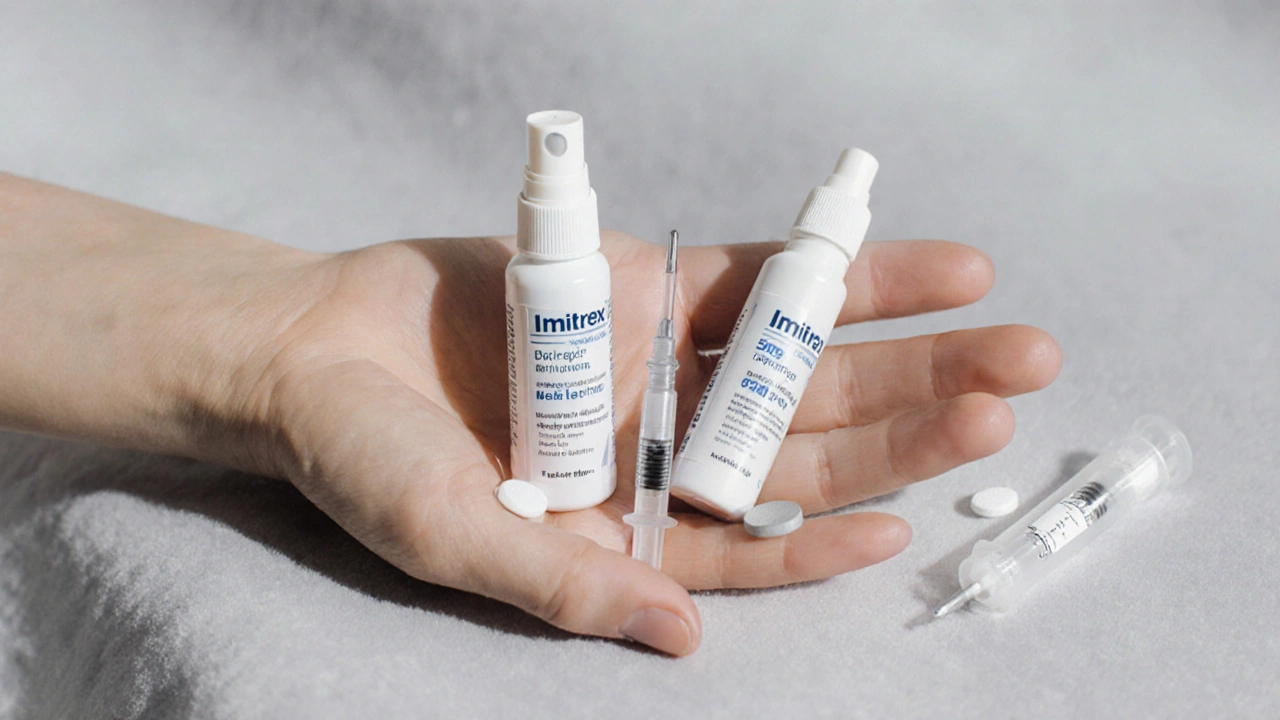Migraine Medication Comparison Tool
Enter your concerns and migraine pattern, then click "Compare Medications" to see personalized recommendations.
Quick Summary
- Imitrex (sumatriptan) works fastest for many users, but newer oral and injectable options offer different onset times and side‑effect profiles.
- Classic triptans (zolmitriptan, rizatriptan) are similar in efficacy; choose based on how quickly you need relief and your tolerance for nausea.
- Non‑triptan alternatives such as lasmiditan, rimegepant and CGRP antibodies provide options for patients with cardiovascular risk.
- Cost and insurance coverage vary widely; generic sumatriptan is usually cheapest, while newer agents can be several times more expensive.
- Always check contraindications (heart disease, hypertension) before switching; a neurologist can help match a drug to your migraine pattern.
What Is Imitrex?
Imitrex is a brand name for sumatriptan, a selective 5‑HT1B/1D receptor agonist that narrows cranial blood vessels and blocks pain pathways in the brainstem. It was approved by the FDA in 1992 and remains one of the most prescribed acute migraine treatments. Available forms include 25mg oral tablets, 6mg subcutaneous injections, and a 20mg nasal spray.

How Triptans Work - The Science Behind Imitrex
Triptans belong to a drug class that targets serotonin receptors located on blood vessels and nerve endings. By activating 5‑HT1B receptors, they cause vasoconstriction of dilated intracranial arteries. Simultaneously, 5‑HT1D activation inhibits the release of calcitonin gene‑related peptide (CGRP), a key migraine‑trigger molecule. This dual action usually reduces migraine pain within 30‑60minutes for most patients.
Major Alternatives to Imitrex
While sumatriptan is effective for many, several other medications address the same condition with different strengths and limitations.
- Zolmitriptan is a second‑generation triptan available as a 5mg tablet and a 5mg nasal spray. It offers a slightly faster nasal onset (≈10minutes) but can cause a bitter taste.
- Rizatriptan comes in 5mg and 10mg tablets. Its onset is typically 30minutes, and it may be better tolerated for patients who experience nausea with sumatriptan.
- Lasmiditan is a serotonin 5‑HT1F agonist marketed as Reyvow. It does not constrict blood vessels, making it safer for patients with cardiovascular disease, though it can cause dizziness.
- Rimegepant belongs to the CGRP‑receptor antagonist class (Gepants). It works orally, has a 2‑hour onset, and is approved for both acute treatment and preventive use.
- Ubrogepant is another CGRP antagonist taken as a 50mg or 100mg tablet. It avoids vasoconstriction and is useful for patients who cannot tolerate triptans.
- Erenumab is a monoclonal antibody that blocks the CGRP receptor. Administered via monthly injection, it is a preventive option rather than an acute rescue medication.
- Migraine is a neurological disorder characterized by recurrent, moderate‑to‑severe head pain, often accompanied by nausea, photophobia, and phonophobia.
Direct Comparison Table
| Medication | Drug Class | Typical Onset | Duration of Relief | Formulations | Major Contra‑indications | Approx. U.S. Price (single dose) |
|---|---|---|---|---|---|---|
| Imitrex | Triptan (5‑HT1B/1D) | 30‑60min (tablet) | 4‑6hrs | 25mg tablet, 6mg injection, 20mg nasal spray | Uncontrolled HTN, CAD, hemiplegic migraine | $10‑$15 (generic) |
| Zolmitriptan | Triptan | 10‑15min (nasal) / 30‑45min (tablet) | 4‑6hrs | 5mg tablet, 5mg nasal spray | Same as sumatriptan | $12‑$18 (generic) |
| Rizatriptan | Triptan | 30‑45min | 4‑8hrs | 5mg/10mg tablet | Same as sumatriptan | $15‑$20 (generic) |
| Lasmiditan | 5‑HT1F agonist | 45‑60min | 6‑12hrs | 50mg, 100mg tablet | Severe hepatic impairment (caution) | $350‑$400 (brand) |
| Rimegepant | CGRP receptor antagonist (Gepant) | ≈2hrs | 8‑12hrs | 75mg tablet | Pregnancy (category C), severe hepatic disease | $200‑$250 (brand) |
| Ubrogepant | CGRP receptor antagonist | ≈1‑2hrs | 6‑8hrs | 50mg, 100mg tablet | Severe hepatic impairment | $150‑$200 (brand) |
| Erenumab | CGRP monoclonal antibody (preventive) | Not for acute relief | Prevents attacks for up to a month | 70mg/140mg subcutaneous injection (monthly) | None specific; caution with immunosuppression | $700‑$800 per month (brand) |

How to Choose the Right Medication
Picking a migraine rescue drug isn’t a one‑size‑fits‑all decision. Follow these practical steps:
- Assess your cardiovascular risk. If you have heart disease, steer clear of classic triptans (sumatriptan, zolmitriptan, rizatriptan) and consider lasmiditan or a CGRP antagonist.
- Identify your migraine pattern. Quick‑onset attacks favor nasal sprays or subcutaneous injections; longer‑lasting attacks may benefit from the extended relief of lasmiditan or gepants.
- Check insurance coverage. Generic sumatriptan is often fully covered, while newer agents may require prior authorization or higher copays.
- Consider side‑effect tolerance. Nausea is common with triptans; dizziness is a hallmark of lasmiditan; liver enzymes should be monitored with gepants.
- Trial and error. Most clinicians recommend trying one triptan first; if ineffective after two attempts, move to an alternative class.
Practical Tips & Common Pitfalls
- Don’t double‑dose too soon. Give each dose at least 2hours before retaking, unless directed otherwise.
- Stay hydrated. Dehydration can worsen migraine and increase the risk of medication‑overuse headache.
- Track your response. Use a simple diary (date, medication, time to relief, side effects) to share with your neurologist.
- Avoid interactions. Triptans combined with SSRIs or SNRIs can raise serotonin syndrome risk; discuss all prescriptions with your doctor.
- Know when to seek emergency care. Sudden, severe headache with fever, neck stiffness, or visual loss may signal a more serious condition.
Frequently Asked Questions
Can I use Imitrex if I have high blood pressure?
Sumatriptan (Imitrex) is generally contraindicated in uncontrolled hypertension because the drug narrows blood vessels. If your blood pressure is well‑managed with medication, some doctors may still prescribe a low dose, but the safest route is to talk with a cardiologist before starting any triptan.
Why does my doctor suggest a nasal spray instead of a tablet?
Nasal sprays bypass the digestive system, delivering medication directly to the cranial blood vessels. This route can cut the onset time to 10‑15minutes for drugs like zolmitriptan, which is helpful when you need fast relief or can’t keep pills down during a migraine.
Are CGRP antagonists safe for people with heart disease?
Yes. CGRP antagonists (e.g., rimegepant, ubrogepant) do not cause vasoconstriction, making them a safer choice for patients with coronary artery disease, angina, or previous stroke. They still require monitoring for liver function, though.
How often can I take a triptan without risking medication‑overuse headache?
Guidelines advise limiting triptan use to fewer than 10 days per month. Exceeding this threshold can convert occasional migraines into a chronic daily headache, which then requires a preventive strategy.
Is there a “best” migraine drug for everyone?
No single drug works best for all patients. Effectiveness depends on individual migraine triggers, comorbid conditions, how quickly you need relief, and how your body tolerates side effects. A trial‑and‑error approach under a doctor’s supervision is the most reliable way to find your ideal medication.

Alyssa Griffiths
October 6, 2025 AT 17:37First, let me clarify, the pharmacodynamics of sumatriptan are well‑documented, and any claim that it is somehow "magically" superior to newer agents is simply erroneous; the drug acts as a 5‑HT1B/1D agonist, causing vasoconstriction, and while this mechanism is effective for many, it also introduces a cascade of contraindications that are often glossed over in mainstream discussions, especially regarding uncontrolled hypertension, coronary artery disease, and hemiplegic migraine variants; moreover, the oral formulation’s bioavailability is limited by first‑pass metabolism, which can be a critical factor for patients with gastrointestinal disturbances, and the subcutaneous injection, while fastest‑acting, carries its own set of complications such as injection site pain and patient aversion to needles; in contrast, the nasal spray formulation bypasses hepatic metabolism, delivering drug directly to the cranial vasculature within minutes, a fact that is corroborated by multiple double‑blind trials; however, one must not ignore the bitter taste and potential for nasal irritation, which can reduce adherence; additionally, while generic sumatriptan is cost‑effective, the pricing dynamics of newer gepants like rimegepant and ubrogepant, though higher, reflect the extensive research and development investments necessary to create non‑vasoconstrictive options-options that are indispensable for patients with cardiovascular risk factors that preclude triptan use; furthermore, the emergence of CGRP monoclonal antibodies, such as erenumab, represents a paradigm shift toward preventive therapy, reducing attack frequency rather than merely aborting attacks; yet, they demand monthly injections and considerable financial outlay, which may be prohibitive for many; let us not forget the importance of individualized therapy, as pharmacogenomic variations can influence drug metabolism, leading to either subtherapeutic response or heightened adverse effects; finally, while many sources tout the convenience of sumatriptan, the reality is that a nuanced, patient‑centered approach, incorporating migraine diaries, cardiovascular assessment, and insurance considerations, is essential for optimal outcomes, and any oversimplified endorsement of one drug over another is, frankly, a disservice to the migraine community.
Jason Divinity
October 7, 2025 AT 21:24It is incumbent upon us, as discerning citizens, to acknowledge that the United States has spearheaded the development of countless pharmaceutical innovations, sumatriptan included; however, a balanced assessment reveals that the pursuit of speed in onset must be weighed against safety profiles, particularly for individuals with latent cardiovascular pathology; the integration of advanced pharmacokinetic modeling, championed by American research institutions, underscores the necessity of personalized dosage regimens, thereby mitigating the risk of adverse events while preserving therapeutic efficacy.
andrew parsons
October 9, 2025 AT 01:10Allow me to correct the aforementioned statements: the usage of "tripans" is not a whimsical term but a precise classification; furthermore, the phrase "people can use it" neglects the mandatory medical supervision required for such potent agents-any deviation from protocol is a breach of ethical standards; please remember to capitalize "Migraine" when referencing the disorder; also, the dosage conversions you presented are inaccurate-refer to the FDA label for exact figures. 😊👍
Sarah Arnold
October 10, 2025 AT 04:57Hey folks! 🌟 If you're hunting for a migraine rescue that won’t break the bank, start with generic sumatriptan-most insurers cover it fully, and the side‑effect profile is well understood; but if you have heart disease, steer clear of classic triptans and consider lasmiditan or a CGRP antagonist instead; always keep a headache diary; it’s the best way to pinpoint which drug truly clicks for you.
Rajat Sangroy
October 11, 2025 AT 08:44Take this as a challenge: track your attacks for two weeks, note the time to relief for each medication, then compare the data-if sumatriptan isn’t delivering within 30 minutes, switch to a nasal spray like zolmitriptan or an injection; your brain will thank you for the decisive action!
dany prayogo
October 12, 2025 AT 12:30Oh, wonderful-another glorified spreadsheet that pretends to simplify the complex tapestry of migraine pharmacotherapy; let me point out, dear author, that such reductive tables ignore the nuanced interplay of patient genetics, psychosocial stressors, and co‑morbidities, all of which render any one‑size‑fits‑all recommendation utterly futile; moreover, the emphasis on cost fails to acknowledge that the true price is measured in quality‑adjusted life years, not merely dollars; but please, continue to parade these oversimplified matrices as if they were the ultimate truth-after all, what better way to lull the masses than with neat rows and columns?
Wilda Prima Putri
October 13, 2025 AT 16:17Interesting take-though I’d suggest keeping the tone a bit softer; the data is solid, but the language could be streamlined.
Edd Dan
October 14, 2025 AT 20:04Great table, thanks.
Cierra Nakakura
October 15, 2025 AT 23:50👍 This really helps me decide which medication to ask my doctor about next; I’ll definitely try the nasal spray for faster relief! 😊
Sharif Ahmed
October 17, 2025 AT 03:37Ah, the sweet symphony of clinical nuance! Let us, for a moment, bask in the grandeur of pharmacologic poetry, where each molecule waltzes upon the synaptic stage, delivering relief with the elegance of a seasoned virtuoso; in this theater of therapeutics, the humble sumatriptan, though venerable, must bow to the avant‑garde of CGRP antagonists, whose very essence embodies the future of headache medicine-an ode to progress, draped in the silken robes of scientific ingenuity.